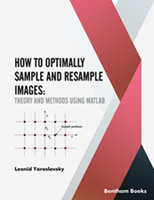Digital imaging and image processing are among the major components of the modern information technologies. Their very fundamental operation is a conversion of analog signals of image sensors into digital signals, i.e. into arrays of numbers that are stored and processed in the memory of digital cameras and computers, transmitted via digital communication channels and used for re-creating images in display devices. This conversion is implemented through image sampling, i.e. through taking, in one or another way, signal samples at certain positions throughout the image area.
Optimal design and implementation of image sampling require answering the question:
- - What is the minimal sampling rate, i.e., the minimal amount of numbers sufficient for representing images with a given accuracy?
- - How can one sample images with sampling rates close the theoretical minimum?
- - Is it possible to implement image resampling without introducing additional distortions due to the resampling?
The book answers these questions. It provides both the most updated formulations of the sampling theory and practical algorithms of image sampling with sampling rates close to the theoretical minimum, as well as it introduces interpolation error free methods of image resampling. In addition, the book presents a number of examples of applications of the described methods for signal and image quasi-continuous spectral and correlation analysis, image rotation and arbitrary image geometrical transformations, precise numerical differentiation and integration, image reconstruction from projections with super-resolution. The book is intended for graduate students, researchers and professionals in imaging science and engineering. The book is supplemented by a MATLAB© program package for exercising.
About the author
Leonid P. Yaroslavsky is a Fellow of the Optical Society of America. He obtained his MS from Faculty of Radio Engineering, Kharkov Polytechnic Institute, Kharkov, Ukraine, Ph.D. from Institute for Information Transmission Problems, Moscow, Russia, and Dr. Sc. Habilitatus in Physics Mathematics from State Optical Institute, S.-Petersburg, Russia. Dr. Yaroslavsky was head of Digital Image Processing and Digital Holography at the Institute for Information Transmission Problems, Russian Academy of Sciences, which in particular, carried out digital processing of images transmitted from space ships Mars-4, Mars-5, Venue-9 and Venus -10 and obtained first color images of surface of Mars and first panoramas from surface of Venus. At present, Dr. Yaroslavsky is a Professor Emeritus. He was the head of the Laboratory of Digital Optics at the Institute and Professor at Faculty of Engineering, Tel Aviv University. He was also a visiting Professor at various universities around the world. He supervised more than 20 Ph. D. candidates and is an author and editor of several books and more than 100 papers on digital image processing and digital holography.
Key words:
Sampling, Sampling theorem, Signal resampling, Sampling distortions, Compressed sensing, Signal sparsity, Integral Fourier Transform, Discrete Fourier Transform, Discrete Cosine transform, Wavelets, Image rotation, Numerical differentiation, Numerical integration, Computed tomography
For further details, please visit: http://bit.ly/368LvDa

